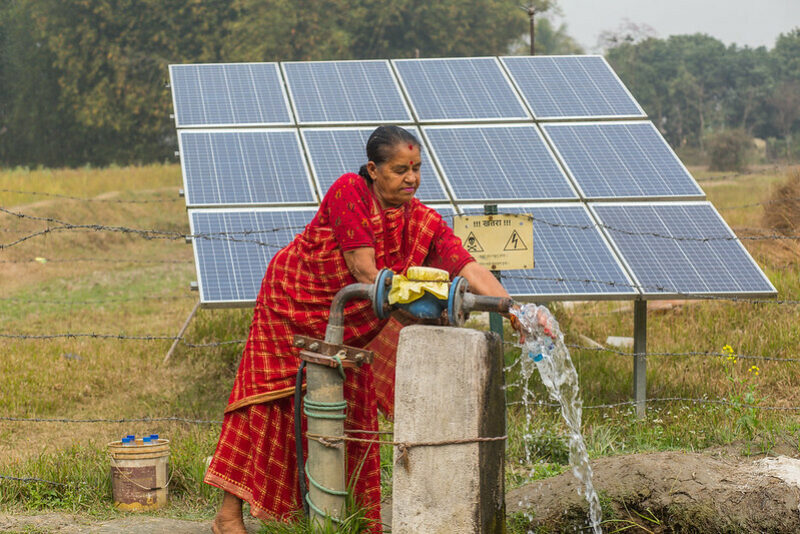Nepal’s ambitious climate target has socio-economic prosperity at its heart
Share

Nepal is a country whose fragile topography, climate sensitive socio-economic structure and limited adaptive capacity makes it among those most at risk from rising temperatures. Taking this vulnerability into account, as well as its aspiration to transition to a middle-income country within this decade, Nepal’s revised 2020 NDC plans for a climate-resilient, prosperous society that will also reach net zero greenhouse gas (GHG) emissions by 2050.
On the eve of the UN Secretary-General’s Climate Ambition Summit, organised to celebrate the fifth anniversary of the Paris Agreement, Nepal submitted its 2020 NDC to the UNFCCC Secretariat. In his speech at the Thimphu Ambition Summit a day later Nepal’s Environment Minister’s urged all nations to follow suit and work together to limit warming to 1.5°C.
Nepal’s new NDC is more ambitious and progressive than its previous committment, both in terms of its targets as well as coverage. It includes quantified mitigation targets and supporting policies that will be implemented within this decade to reduce the country’s emissions and increase its carbon sink.
Key among these targets is Nepal’s ambition to increase clean and renewable energy production (from hydropower, solar, wind and bio-energy) tenfold to 15,000 MW by 2030. This would meet around 15% of the total energy demand of the country. Among other things, this clean energy would help Nepal adopt more electric transportation and cooking technologies, replacing a significant proportion of fossil fuel imports. In its revised NDC, Nepal aims to ensure that 90% of private and 60% of public vehicle sales will be electric by 2030. Within the same timeframe, it also commits to have 25% of Nepali households use electric stoves as their primary mode of cooking. Through such interventions the government aims to reduce almost a third of the emissions from the transportation sector and more than a fifth of the emissions from cooking.
To reduce emissions from its agricultural sector, Nepal looks to improve land and livestock management. The country also plans to reduce coal consumption and promote low emissions technologies in its brick and cement industries.
It envisions scaling up public and private management of wastewater and fecal sludge by 2025 to reduce its waste sector emissions. It also plans to adopt waste segregation, promote waste-to-energy programs, and increase the co-production of energy and organic fertiliser from solid waste, wastewater and faecal sludge.
Nepal has also adopted targets to promote nature-based tourism, carbon neutral tourist destinations and low carbon and climate resilient urban planning. In order to increase carbon sinks, the country aims to maintain 45% of its area under forest cover and start sustainable management of large portions of these forests.
Beyond 2030, Nepal’s NDC also plans to devise and implement a low greenhouse gas emission development strategy to achieve net zero GHG emissions by 2050 — a commitment reinforced by the Prime Minister during the Climate Ambition Summit. Together, these mitigation targets will serve to not only improve climate outcomes, but also boost air quality, citizen health and well-being, and the economy of the country.
Because of its high vulnerability to climate change, adaptation remains a prime concern for the country. In its NDC, Nepal highlights key adaptation priorities, including its intention to prepare and implement climate-resilient and gender-responsive adaptation plans for all local units, to develop a National Adaptation Plan and periodically update it, to establish appropriate institutional mechanisms and strategies, to monitor impacts of climate change on health, and to introduce public weather services and early warning systems. Nepal communicates that it will further expand on these critical adaptation measures within this year in its National Adaptation Plan.
Nepal’s revised NDC has also been lauded for taking gender equality and social inclusion into consideration. The country aims to ensure full and meaningful participation of women, indigenous communities and youth during all stages of the NDC implementation process. Additionally, it commits to providing gender-disaggregated data while reporting on progress and achievements of the 2020 NDC.
Nepal’s mitigation targets reflect the current highest possible ambition for the country. Implementing them would cost USD $28.4 billion – almost as much as the nation’s entire 2019 GDP. Given this price tag, without support from developed nations, like most Least Developed Countries, Nepal will only be able to deliver on a small fraction of its true mitigation potential. Unlocking the full mitigation capacity of Nepal and other developing countries like it hinges on wealthy nations delivering on their climate finance promises.
NOTE
As the implementing partner of the NDC Partnership’s Climate Action Enhancement Package which helps developing countries formulate and implement ambitious NDCs, Climate Analytics was able to support Nepal’s 2020 NDC formulation process. Our organisation provided a combination of assessments, including policy and trend analysis and GHG emissions modelling, to inform the energy, forestry, agriculture, industry, tourism and urban development sectors. The organisation also assessed climate change risk at the provincial level, helped assess the cost of NDC implementation and performed a cost-benefit analysis of the mitigation targets.
Implementing Nepal’s current NDC, and formulating and implementing subsequent rounds, will require collaboration between the government, development partners, civil society and academia. Climate Analytics aims to work closely with these stakeholders to build NDC-related long-term capacity of in-state actors and ensure knowledge retention at the national level. To this end, our organisation is currently collaborating with the government, development partners, and local universities in particular to help develop a climate change curriculum, short course, and resource booklet for higher education.
Header image: Nepalese farmer with her solar irrigation pump. ©Photo credit: Nabin Baral / IWMI (CC BY-NC 2.0 DEED)













